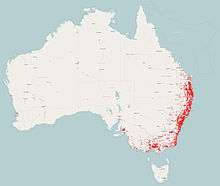Rose robin
| Rose robin | |
|---|---|
| | |
| Male | |
| Scientific classification | |
| Kingdom: | Animalia |
| Phylum: | Chordata |
| Class: | Aves |
| Order: | Passeriformes |
| Family: | Petroicidae |
| Genus: | Petroica |
| Species: | P. rosea |
| Binomial name | |
| Petroica rosea Gould, 1840 | |
 | |
| The distribution of the rose robin Data from The Atlas of Living Australia | |
The rose robin (Petroica rosea) is a small passerine bird native to Australia. Like many brightly coloured robins of the Petroicidae it is sexually dimorphic. The male has a distinctive pink breast. Its upperparts are dark grey with white frons, and its tail black with white tips. The underparts and shoulder are white. The female is an undistinguished grey-brown. The robin has a small black bill and eyes.
It is endemic to Australia east or south of the Great Dividing Range, from Queensland through to southeastern South Australia. Its natural habitats are the gullies and valleys of temperate forests and subtropical or tropical moist lowland forests.
Taxonomy
Like all Australian robins, the rose robin is not closely related to either the European robin or the American robin, but belongs rather to the Corvida parvorder comprising many tropical and Australian passerines including pardalotes, fairywrens and honeyeaters as well as crows. It belongs to the genus Petroica, whose Australian members are known colloquially as "red robins" as distinct from the "yellow robins" of the genus Eopsaltria. It was first described be ornithologist John Gould in 1840, with its specific epithet derived from the Latin roseus 'pink'.[2] Testing of the nuclear and mitochondrial DNA of Australian members of the genus Petroica suggests the rose and pink robins are each other's closest relative within the genus.[3]
Description
Adult birds are around 11 cm (4.3 in) in length. The male rose robin has a pink breast and abdomen, with dark grey head, throat, back and tail, with a white frons and outer tail shafts. There is no white wing bar. The female is plain-coloured; pale grey-brown above, and a grey-white underneath, with small white marks on wings and over the bill. The bill, legs and eyes are black. Both the male and female make a tick call.[4]
Distribution and habitat
The rose robin occurs in eastern and southeastern Australia, from Rockhampton east of the Great Dividing Range through eastern New South Wales and Victoria into southeastern South Australia. It does not occur in Tasmania. It is found in wet sclerophyll forest and rainforest, where it inhabits gullies and valleys, dispersing to drier forest in cooler months.[5] The rose robin is vulnerable to development and clearing of forested areas, which has led to it disappearing in these areas.[6] Populations have been recorded in conservation areas, namely the Dandenong and Scotchmans and Gardiners Creek Corridors, in Melbourne's eastern suburbs.[7]
Behaviour
Found in ones or twos, birds tend to feed in the tops of trees.[4] Insects and spiders form the bulk of the diet, with most being caught while the robin is flying. Unlike other robins, the rose robin does not return to the same branch while foraging.[6] Prey consists of a variety of spiders and insects, including caterpillars, wasps, bugs such as cicadas and cinch bugs, beetles such as jewel beetles, leaf beetles, leaf-eating beetles and weevils, flies and ants.[8]
Breeding
Breeding season is September to January with one or two broods raised. The nest is a neat, deep cup made of bits of moss and fern. Spider webs, feathers and fur are used for binding/filling, while lichen is placed on the nest exterior. The nest is generally situated in the fork of a large tree some 10–20 m (33–66 ft) above the ground. Two or three dull white eggs tinted bluish, greyish or brownish and splotched with dark grey-brown are laid measuring 17 mm x 13 mm.[5] The rose robin has been parasitised by the pallid- (Cuculus pallidus), brush- (Cacomantis variolosus) and Horsfield's bronze cuckoos (Chrysococcyx basalis).[6]
References
| Wikimedia Commons has media related to Petroica rosea. |
| Wikispecies has information related to: Petroica rosea |
- ↑ BirdLife International (2012). "Petroica rosea". IUCN Red List of Threatened Species. Version 2013.2. International Union for Conservation of Nature. Retrieved 26 November 2013.
- ↑ Simpson DP (1979). Cassell's Latin Dictionary (5 ed.). London: Cassell Ltd. p. 883. ISBN 0-304-52257-0.
- ↑ Loynes, Kate; Joseph, Leo; Keogh, J. Scott (2009). "Multi-locus phylogeny clarifies the systematics of the Australo-Papuan robins (Family Petroicidae, Passeriformes)". Molecular Phylogenetics and Evolution 53 (1): 212–19. doi:10.1016/j.ympev.2009.05.012.
- 1 2 Simpson K, Day N, Trusler P (1993). Field Guide to the Birds of Australia. Ringwood, Victoria: Viking O'Neil. p. 174. ISBN 0-670-90478-3.
- 1 2 Beruldsen, G (2003). Australian Birds: Their Nests and Eggs. Kenmore Hills, Qld: self. p. 339. ISBN 0-646-42798-9.
- 1 2 3 Higgins, P.J. and J.M. Peter (eds) 2002. Handbook of Australian, New Zealand and Antarctic Birds, Volume 6: Pardalotes to Shrike-thrushes. Oxford University Press, Melbourne.
- ↑ "Fauna in Monash Indigenous Reserve Corridors". Monash City Council website. Archived from the original on 2008-05-11. Retrieved 2008-05-02.
- ↑ Barker RD, Vestjens WJM (1984). The Food of Australian Birds: (II) Passerines. Melbourne University Press. p. 52. ISBN 0-643-05115-5.
